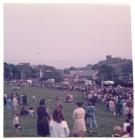Content can be downloaded for non-commercial purposes, such as for personal use or in educational resources.
For commercial purposes please contact the copyright holder directly.
Read more about the The Creative Archive Licence.
Description
Out to sea, on the horizon, from Criccieth is a reef of shingle, stones and boulders. It extends south westwards from Mochras Point for about 20 kms (12 miles) and dries in places at low tides. This is named SARN PADRIG or, in English, ST PATRICK’S CAUSEWAY. The scientific explanation is that it is made of glacial deposits left by receding ice sheets at the end of the last ice age. There is no doubt that sea levels were lower many years ago; fossilised tree trunks are revealed off the Cardigan coast at low tides and evidence of peat beds have been found out to sea from the mouth of the river Dwyfor near Criccieth.
The name Patrick suggests old legends connected with Ireland. Many of these legends also claim that the feature is man-made, the most well known is the story of CANTRE’ GWAELOD, the Bottom Hundred – a “Hundred” being an administrative division of land in ancient times.
A long time ago, if you had looked out south of Criccieth to where Tremadog Bay is today, you would see lush, fertile lands. It was a part of the kingdom of Meirionnydd and ruled by Gwyddno Garanhir. Owing to the low-lying nature of the land, it was protected from the sea by a large dyke. The dyke had sluice gates that were opened at low tide to drain the water from the land, and closed again as the tide returned, but one terrible night, one man’s carelessness caused the drowning of Cantre’r Gwaelod. The man who had the great responsibility of ensuring the gates were closed was Seithennyn. He was in love with the king’s daughter but she was betrothed to another and on the day of her wedding he got very drunk and fell asleep so the gates remained open. A fierce storm blew up pushing the incoming tide onto the land. The people fled but many drowned and that was the end of Cantre Gwaelod.
--------------------------------------------
The reef is very dangerous. Over the centuries dozens of ships have struck it especially in the days of sailing ships. They would get lost because of poor navigation and blunder into the Bay or be blown in by stormy weather. Sometimes, ships sailing up the Irish Sea, bound for Liverpool, would mistake the lighthouse on Bardsey Island for the Irish Coast and alter course to the eastwards and get into trouble. A few would manage to extract themselves, some would be damaged, be blown off the reef and be wrecked on the beaches between Criccieth and Morfa Harlech and some would be totally wrecked on the Causeway.
The lifeboats of Pwllheli, Abersoch, Criccieth and Barmouth have rescued hundreds of people over the years but sadly, many poor sailors drowned






Do you have information to add to this item? Please leave a comment
Comments (0)
You must be logged in to leave a comment